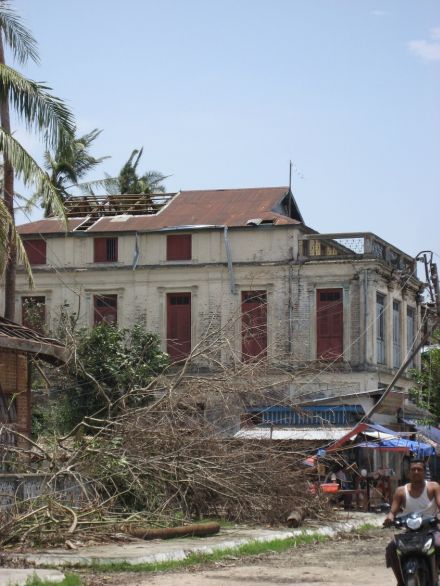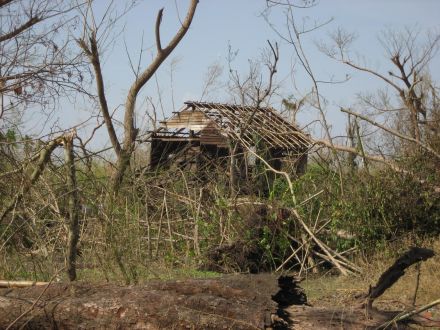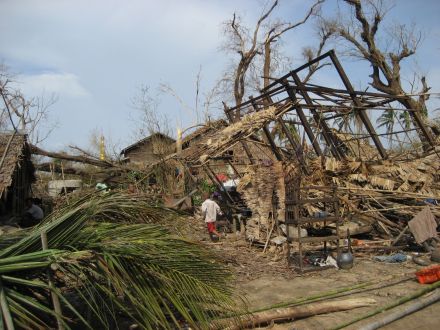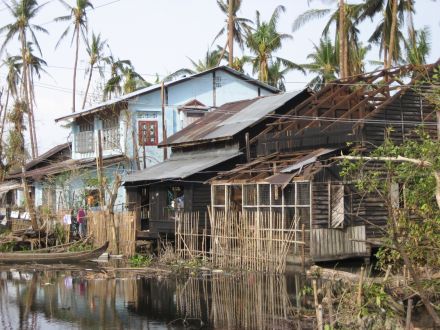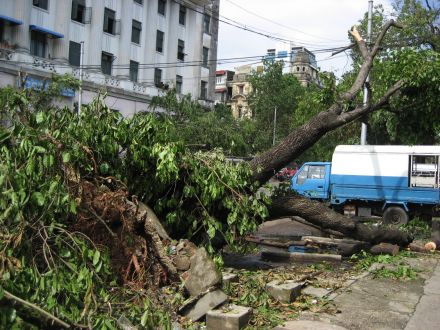A New Mandala correspondent in Yangon has put together this account about Cyclone Nagris and the ongoing effort to bring aid to people in the Irrawaddy delta. The above picture was taken in Dedaye in the storm-affected area.
The images of destruction and devastation in and around Yangon after the cyclone will stay with me for a long time, but it is the eyewitness reports of survivors in a small village outside Kunyangon in the Delta that I will remember for the rest of my life.
– A small house destroyed by the cyclone.
One week after the cyclone I traveled by public transport along the road from Yangon to Kunyangon to Dedaye in the delta. On the way I stopped in a small village that had nearly been completely destroyed. The stories from the night of the cyclone that the villagers shared with me were gruesome. I was told how streets were turned into rivers through torrential rainfall and storm surges of over 10 feet. While winds approaching 200 km per hour caused much of the material damage, it was the pounding of flood waters that claimed most of the lives lost. People were literally swept away by the water and drowned. One woman told me how women with babies strapped to their backs tried to escape the rising water by climbing trees. However, the wind was so strong that some of the babies were torn away, mothers being forced to watch their babies perish in the water below. Another man talked about bodies carried through their village by the force of the water, some of them dead, some of them alive. Facing so many bodies the villagers decided that they would only try to pull those bodies from the water that belonged to friends, family or relatives of the villagers. This village considered itself to be fortunate. Few villagers died here, whereas in a neighbouring village 60 % of the population was feared lost.
– A small boy runs through the remains of a village.
Dedaye is approximately three hours by public transport from Yangon. All along the road during the three hour trip through delta villages, the bus passed partly or fully destroyed homes and buildings. In Dadaye, the local police station had been turned into the primary help center. People from and around Dadeye could come here to report their losses and damages and be allocated help. Local Red Cross and Unicef workers were prevalent, as truckloads of rice, water and tents made their way into Dedaye.
– Residential buildings in Kunyangon.
In Kunyangon, a small town, every single building was damaged. People gathered leftover belongings and hung them in semi or fully destroyed houses to dry. The people I talked to were eager to pick up their normal lives. It is not only devastating that many lost all their property, but long term income generating opportunities have been drastically interrupted or altogether destroyed. Relief goods reached the people within a couple of days, but in modest rations far from sufficient. Families in Kunyangon received one package of instant noodles and one egg a day, families from surrounding villages who had come to Kunyangon to collect aid received just over four kilograms of rice per family a week. Some families received cash from the government.
Though I have spent the last several weeks in Myanmar, I was fortunate to have been out of town when the cyclone struck two weeks ago. I returned to Yangon on the fourth day after the cyclone, as soon as the road was reopened. Until my return I was not aware of the extent of the devastation. Though I had been told there was a storm, no detailed information was available. Then, 45 minutes outside Yangon, on the road between Pyay and the former capital, I first witnessed scenes of the utter destruction. Huge trees were uprooted, electrical poles broken into small pieces, cables strewn all over and roofs blown away. On my way into downtown Yangon I had difficulty recognizing familiar corners. Debris was piled up everywhere and many landmarks were damaged beyond recognition. There was no electricity, no phone connections, and the majority of the trees in Yangon lay strewn across the ground.
– A blocked road in Yangon in the days after the cyclone.
The next morning I was able to meet some of my friends in their neighborhoods and I was relieved to find them all well, although most of their houses had suffered extensive damage. The price of water and petrol had substantially increased. While the price of drinking water has since returned to its pre-cyclone level, petrol remains at the grossly inflated post-cyclone price of over 10,000 kyat (approximately U.S. $10) per gallon.
– More damage in Yangon.
In the ensuing days in central Yangon, the removal of debris from the streets proceeded in a timely manner. Soldiers and citizens were working hard to restore normal living conditions, and within days nearly all roads were passable and after seven days electricity was restored to most of central Yangon.
While the provision of international aid was quickly politicized, the response of many local groups was prompt and unconditional. Local aid relief groups were formed immediately by Myanmar citizens who were aware that besides official relief works, alternative channels of help needed to be provided. Some of the private initiatives obtained official permits to engage in relief works, while others operated on an ad-hoc basis, gathering relief goods and delivering them via private vehicles and boots.
Those organisations who attempted to obtain a permit in order to operate in the delta were often faster than international agencies to do so. Some of these organisations have been involved in philanthropic activities in Myanmar for a long time and necessary connections to obtain permits existed prior to the natural disaster. Yet, it is a mistake to assume that any local organisation that obtained a permit must be associated with the government, the government is aware that there are no political strings attached to their work and finds it easier to trust these organisations than international organisations that often have a history of tenuous relations with the government. The work of many of the private initiatives, whether conducted with a permit or not, has in many cases been made possible by generous donations from Myanmar businessmen and citizens, from home and abroad. In one example, a local businessman whom I met spoke of donating tens of thousands of dollars to trusted organisations and individuals.
– A Myanmar government billboard outside the former US Embassy in Yangon that did not survive the carnage.
The hundreds of thousands affected by the deadly storm will need assistance for a long time to come. Vast areas of rice paddy have been destroyed and now stand contaminated with the salt water that flooded the fields. Additionally, the onset of the rainy season is currently further aggravating the situation of people who do not have sufficient shelter. While many relief goods have been distributed, many isolated villages have yet to be reached and other areas that have received support will soon be in need of additional aid.
As cyclone survivors struggle to put lives and homes back together, I hope people who are in situations that allow them to support affected communities will do so, regardless of political considerations.
*If you are interested in helping the victims of the cyclone please visit www.nargisaction.org. This local organisation provides support and necessary assistance directly to survivors.*
 Facebook
Facebook  Twitter
Twitter  Soundcloud
Soundcloud  Youtube
Youtube  Rss
Rss 